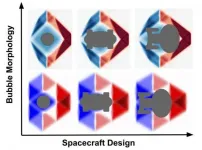Floral probiotics reduce apple disease
2021-03-09
(Press-News.org) While many celebrate apple blossoms as classic signs of spring, they are also welcoming entry gates for pathogens. Full of nutrients to lure pollinators and promote pollen germination, flowers also attract bacteria like Erwinia amylavora, a pathogen that causes a damaging disease called fire blight. However, recent work by scientists at the Connecticut Agricultural Experiment Station suggests that these flowery infection sites might also be perfect targets for applying microbial fire blight biocontrol measures.
In a paper recently published in Phytobiomes Journal, researchers Zhouqi Cui, Regan Huntley, Neil Schultes, Blaire Steven, and Quan Zeng found that treating apple flowers with a probiotic spray reduced incidence of fire blight. They sprayed blooming trees with different strains of bacteria isolated from apple flowers and then exposed the same blooms to the fire blight pathogen. After this inoculation, they sampled the floral microbiomes and observed the development of fire blight symptoms.
They found flowers treated with Pantoea spp. bacteria developed distinct microbiomes and exhibited fire blight symptoms 35 to 45 percent less frequently than flowers treated with just water. These results suggest that Pantoea spp. structure floral microbiomes in a way that reduces infection and could be an effective probiotic biocontrol for fire blight. Flowers may be a particularly promising system in which growers can actively influence microbiomes--compared to roots and leaves, flowers are short-lived, which could make reshaping their microbiomes both more technically feasible and biologically impactful.
This research underscores the importance of studying apple flower ecology in the field. While many researchers simply screen bacterial isolates in the laboratory, Cui and colleagues studied how these natural strains altered flower microbiomes and disease rates in the field. This step was crucial as the bacterial strain that suppressed the fire blight pathogen most strongly in the lab failed to substantially reduce infections in the field while Pantoea spp., the strain with the promising fire blight reduction in the field, did not directly suppress pathogen growth in the lab.
The authors suggest that the ineffectiveness of biocontrol agents in field settings may be due to the products' incompatibility with natural plant microbiomes. "Typical studies...often fail to even test if the applied strain effectively colonizes the flower" the authors note. As evidenced in their study, laboratory results can sometimes show false promise, but in some incidences--as with the case of Pantoea, may allow promising biocontrol agents to be overlooked.
INFORMATION:
To learn more about this research, read the original article published in Phytobiomes Journal: "Inoculation of Stigma-Colonizing Microbes to Apple Stigmas Alters Microbiome Structure and Reduces the Occurrence of Fire Blight Disease."
The lead researcher on this project, Dr. Zhouqi Cui (@CuiZhouqi), is interested in the dynamic interactions between the plant microbiome and plant pathogens on agricultural crops. She is currently a postdoctoral scientist at the Connecticut Agricultural Experiment Station (@CT_CAES) and is looking for a permanent research position in the near future. Dr. Blaire Steven, a co-PI on this project is a microbial ecologist with broad interests in how microbial communities are acquired and assembled. His work includes the microbial ecology of permafrost, desert and agricultural soils, the mosquito microbiome, as well as the work on the apple flower phytobiome. Dr. Quan Zeng (@oldkayak), the corresponding author, is an Associate Scientist in the Department of Plant Pathology and Ecology, Connecticut Agricultural Experiment Station and graduate faculty at the Department of Plant Science and Landscape Architecture, University of Connecticut. His research interests include plant-associated microbiomes and their impact on plant diseases, and bacterial plant pathogens and diseases.
Author Bio: Dr. Mia Howard (@mia_how) is an assistant feature editor for Phytobiomes Journal and a postdoctoral researcher in Dr. Jen Lau's lab at Indiana University. She is fascinated by how plants--often with help from microbes--protect themselves from herbivores with toxic chemicals.
[Attachments] See images for this press release:

ELSE PRESS RELEASES FROM THIS DATE:
2021-03-09
LA JOLLA, CA--Translational research led by scientists at La Jolla Institute for Immunology (LJI) has resulted in a promising combination therapeutic candidate for adults with recent-onset type 1 diabetes.
The combination therapy was recently tested in a randomised, double-blind, placebo-
controlled, phase 2 trial run and funded by pharmaceutical company Novo Nordisk. The results, published recently in The Lancet Diabetes and Endocrinology, point to a potential way to treat the autoimmune disease without leaving the body vulnerable to infectious disease.
The therapeutic candidate combines anti-IL-21 antibody with the diabetes drug liraglutide. This ...
2021-03-09
COLUMBIA, Mo. - In the midst of a pandemic that has claimed more than 2 million lives worldwide and disrupted nearly every facet of society since it appeared more than a year ago, understanding the factors that create and facilitate disease outbreaks is more important than ever. Now, researchers at the University of Missouri have determined that cognitive biases -- patterns of errors in thinking that affect judgments and behaviors, often unconsciously -- can help create and worsen foodborne disease outbreaks.
"Unethical behavior isn't always intentional; conflicts of interest and other unconscious motivations can lead people to behave ...
2021-03-09
WHAT:
Approximately two years after establishing a human cerebral organoid system to study Creutzfeldt-Jakob disease (CJD), National Institutes of Health researchers have further developed the model to screen drugs for potential CJD treatment. The scientists, from NIH's National Institute of Allergy and Infectious Diseases (NIAID), describe their work in Scientific Reports.
Human cerebral organoids are small balls of human brain cells ranging in size from a poppy seed to a pea; scientists use human skin cells to create them. CJD, a fatal neurodegenerative brain disease of humans caused by infectious prion proteins, affects about 1 in 1 million people each year. It can arise spontaneously, result from ...
2021-03-09
Philadelphia, March 9, 2021 - Schizophrenia is a neurodevelopmental disorder that disrupts brain activity producing hallucinations, delusions, and other cognitive disturbances. Researchers have long searched for genetic influences in the disease, but genetic mutations have been identified in only a small fraction--fewer than a quarter--of sequenced patients. A new study now shows that "somatic" gene mutations in brain cells could account for some of the disease neuropathology.
The study, led by senior author Jeong Ho Lee, MD, PhD, at Korea Advanced Institute of Science and Technology and the team of Stanley Medical Research Institute, appears in Biological ...
2021-03-09
According to the current BfR-Corona-Monitor of the German Federal Institute for Risk Assessment (BfR), 43 percent of the respondents have already had themselves tested for the virus. The survey, which has been conducted regularly for almost a year now, documents how the population is dealing with the situation, what they are doing to protect themselves and how they are informing themselves about the current events. "For 50 weeks now, our survey has provided insights into the current situation and its development," says BfR-President Professor Dr. Dr. Andreas Hensel. "Over time, we see that the vast majority of the population is implementing the key protective measures."
BfR-Corona-Monitor as to 2-3 March 2021:
https://www.bfr.bund.de/cm/349/210302-bfr-corona-monitor-en.pdf
Regarding ...
2021-03-09
PLYMOUTH MEETING, PA [March 9, 2021] -- New research in the March 2021 issue of JNCCN--Journal of the National Comprehensive Cancer Network from Mass General Hospital Cancer Center, Harvard Medical School, and Dana-Farber Cancer Institute finds muscle mass (quantity) correlated with survival, while muscle radiodensity (quality) was associated with symptom burden, healthcare use, and survival in patients with advanced cancer undergoing an unplanned hospitalization. The researchers also found nearly two-thirds of the patients in that population had significant muscle loss ...
2021-03-09
BUFFALO, N.Y. -- New research from the University at Buffalo suggests that breast cancer patients who drink sugar-sweetened beverages regularly are at increased risk for death from any cause and breast cancer in particular.
Compared to women who never or rarely drank non-diet soda, those who reported drinking non-diet soda five times or more per week had a 62% higher likelihood of dying from any causes, and were 85% more likely to die from breast cancer specifically. The findings were published online ahead of print March 2 in Cancer Epidemiology, Biomarkers & Prevention, a journal of the American Association for Cancer Research.
Research on soda and breast ...
2021-03-09
Researchers at Uppsala University have developed a digital self-test that trains users to assess news items, images and videos presented on social media. The self-test has also been evaluated in a scientific study, which confirmed the researchers' hypothesis that the tool genuinely improved the students' ability to apply critical thinking to digital sources.
The new tool and the scientific review of it are part of the News Evaluator project to investigate new methods of enhancing young people's capacity for critical awareness of digital sources, a key component of digital literacy.
"As ...
2021-03-09
Philadelphia, March 9, 2021--Combining computational mining of big data with experimental testing in the lab, researchers at Children's Hospital of Philadelphia (CHOP) have identified RNA editing events that influence gene expression and, in turn, the phenotypic manifestation of that expression. In analyzing so-called A-to-I RNA editing, in which the adenosine of an RNA molecule is chemically modified into an inosine, the researchers describe how a single nucleotide change by RNA editing can have large downstream effects. The findings were published today in Genome Biology.
"Millions of A-to-I RNA editing sites have been identified across the human transcriptome, but the functions of most RNA editing ...
2021-03-09
If travel to distant stars within an individual's lifetime is going to be possible, a means of faster-than-light propulsion will have to be found. To date, even recent research about superluminal (faster-than-light) transport based on Einstein's theory of general relativity would require vast amounts of hypothetical particles and states of matter that have "exotic" physical properties such as negative energy density. This type of matter either cannot currently be found or cannot be manufactured in viable quantities. In contrast, new research carried out at the University of Göttingen gets around this problem by constructing a new class of hyper-fast 'solitons' ...
LAST 30 PRESS RELEASES:
[Press-News.org] Floral probiotics reduce apple disease







